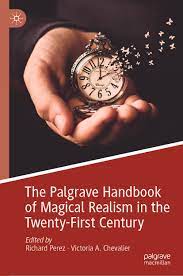Book review: The Palgrave Handbook of Magical Realism in the Twenty-First Century
Main Article Content
Abstract
Edited by Richard Perez and Victoria A. Chevalier. Palgrave Macmillan, Cham (Switzerland), 2020. xxi + 650 pp.
Magical realism has a chequered history with beginnings in Europe. Magischer Realismus or “magic realism” was coined by German art critic, Franz Roh, in 1923 to describe certain metaphysical elements that he saw in paintings. However, the term did not gain currency—Neue Sachlichkeit (New Objectivity) and eventually Post-Expressionism became more accepted terms (Crockett 1999, 148–155). Magical realism found its way into literature when Massimo Bontempelli (1878–1960), an Italian writer and critic, first applied the term to literature in 1926 (Walter 1993, 13). But it only gained popularity in the 1950s and 1960s when it was used to describe the “boom” literary phenomenon of Latin American fiction. And it was in Latin America that this aesthetic category developed as a form of postcolonial resistance and discourse. However, this malleable and contentious term is difficult to define. Some critics have even said it defies definition; yet there is a tacit understanding of the term. At the basic level, magical realism deals with the real and irreal in quotidian or everyday life and does not dichotomise the two. Amaryll Beatrice Chanady’s Magical Realism and the Fantastic: Resolved Versus Unresolved Antinomy (1985) demonstrates the blending of the real and irreal in Latin American fiction and differentiates magical realism from the fantastic, arguing that the fantastic create antinomies of the real and irreal. However, the European strand of magical realism (especially with Eastern Europe) is more complex and with its influence of Freud and Surrealism, challenges Chanady’s ideas.
Article Details

This work is licensed under a Creative Commons Attribution 4.0 International License.
References
Chanady, A. B. 1985. Magical realism and the fantastic: Resolved versus unresolved antinomy. New York: Garland Publisher, Inc.
Crockett, D. 1999. German post-expressionism: The art of the great disorder 1918–1924. University Park: Pennsylvania State University Press.
Hart, S. M. and W. C. Ouyang. 2005. A companion to magical realism, eds. Woodbridge: Tamesis.
Walter, R. 1993. Magical realism in contemporary Chicano fiction: Ron Arias, the road to Tamazunchale (1975); Orlando Romero, Nambe-year one (1976); Miguel Mendez M., the dream of Santa Maria de las piedras (1989). Frankfurt: Vervuert Verlag. https://doi.org/10.31819/9783964562371
Zamora, L. P. and W. B. Faris. 1995. Magical realism: Theory, history, community, eds. Durham: Duke University Press. https://doi.org/10.1515/9780822397212
